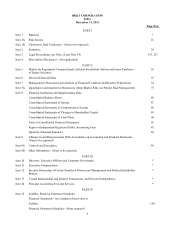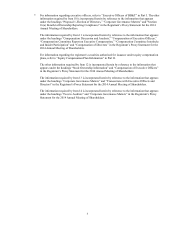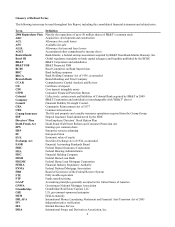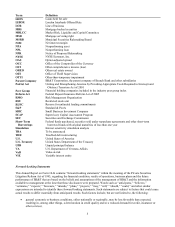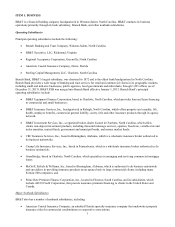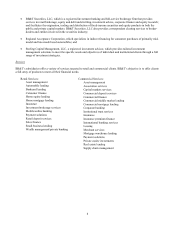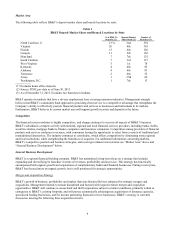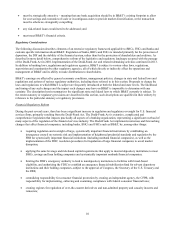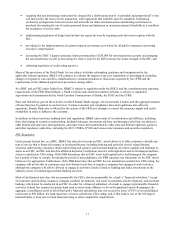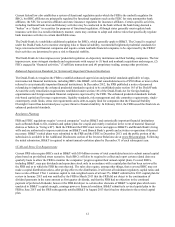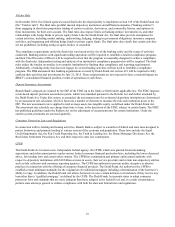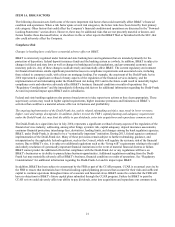BB&T 2013 Annual Report Download - page 11
Download and view the complete annual report
Please find page 11 of the 2013 BB&T annual report below. You can navigate through the pages in the report by either clicking on the pages listed below, or by using the keyword search tool below to find specific information within the annual report.
11
requiring that any interchange transaction fee charged for a debit transaction be “reasonable and proportional” to the
cost incurred by the issuer for the transaction, with regulations that establish such fee standards, eliminating
exclusivity arrangements between issuers and networks for debit card transactions and limiting restrictions on
merchant discounting for use of certain payment forms and minimum or maximum amount thresholds as a condition
for acceptance of credit cards;
implementing regulation of hedge fund and private equity advisers by requiring such advisers to register with the
SEC;
providing for the implementation of certain corporate governance provisions for all public companies concerning
executive compensation;
increasing the FDIC’s deposit insurance limits permanently to $250,000 for non-transaction accounts and changing
the assessment base as well as increasing the reserve ratio for the DIF to ensure the future strength of the DIF; and
reforming regulation of credit rating agencies.
Many of the provisions of the Dodd-Frank Act are subject to further rulemaking, guidance and interpretation by the
applicable federal regulators. BB&T will continue to evaluate the impact of any new regulations so promulgated, including
changes in regulatory costs and fees, modifications to consumer products or disclosures required by the CFPB and the
requirements of the enhanced supervision provisions, among others.
As a BHC and an FHC under federal law, BB&T is subject to regulation under the BHCA and the examination and reporting
requirements of the FRB. Branch Bank, a North Carolina state-chartered commercial bank, is subject to regulation,
supervision and examination by the North Carolina Commissioner of Banks, the FDIC and the CFPB.
State and federal law govern the activities in which Branch Bank engages, the investments it makes and the aggregate amount
of loans that may be granted to one borrower. Various consumer and compliance laws and regulations also affect its
operations. Branch Bank also is affected by the actions of the FRB as it attempts to control the monetary supply and credit
availability in order to influence the economy.
In addition to federal and state banking laws and regulations, BB&T and certain of its subsidiaries and affiliates, including
those that engage in securities underwriting, dealing, brokerage, investment advisory and insurance activities, are subject to
other federal and state laws and regulations, and supervision and examination by other state and federal regulatory agencies
and other regulatory authorities, including the SEC, FINRA, NYSE and various state insurance and securities regulators.
FHC Regulation
Under current federal law, as a BHC, BB&T has elected to become an FHC, which allows it to offer customers virtually any
type of service that is financial in nature or incidental thereto, including banking and activities closely related thereto,
securities underwriting, insurance (both underwriting and agency) and merchant banking. In order to qualify and maintain its
status as an FHC, an FHC and all of its affiliated depository institutions must be well-capitalized and well-managed and have
at least a satisfactory CRA rating. If the FRB determines that an FHC is not well-capitalized or well-managed, the company
has a period of time to comply, but during the period of noncompliance, the FRB can place any limitations on the FHC that it
believes to be appropriate. Furthermore, if the FRB determines that an FHC has not maintained a satisfactory CRA rating, the
company will not be able to commence any new financial activities or acquire a company that engages in such activities,
although the company will still be allowed to engage in activities closely related to banking and make investments in the
ordinary course of conducting merchant banking activities.
Most of the financial activities that are permissible for FHCs also are permissible for a bank’s “financial subsidiary,” except
for insurance underwriting, insurance company portfolio investments, real estate investments and development, and merchant
banking, which must be conducted in an FHC. In order for a financial subsidiary of a bank to engage in permissible financial
activities, federal law requires the parent bank (and its sister-bank affiliates) to be well-capitalized and well-managed; the
aggregate consolidated assets of all of that bank’s financial subsidiaries may not exceed the lesser of 45% of its consolidated
total assets or $50 billion; the bank must have at least a satisfactory CRA rating; and, if that bank is one of the 100 largest
national banks, it must meet certain financial rating or other comparable requirements.


